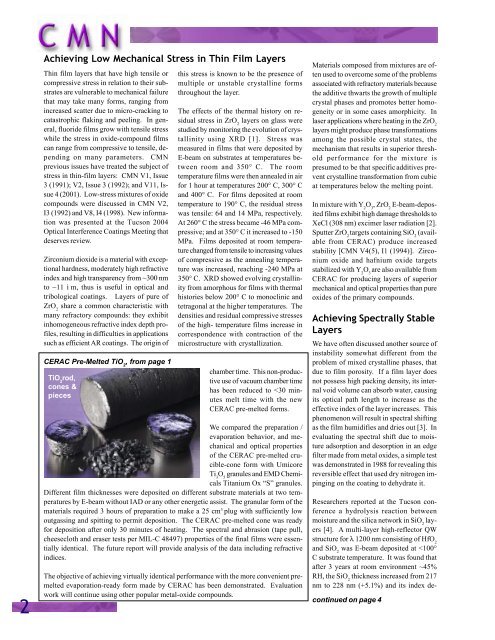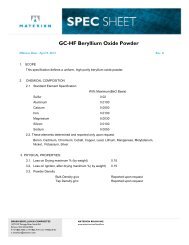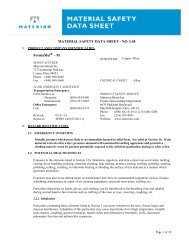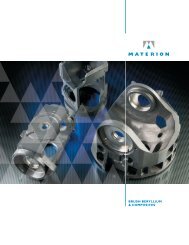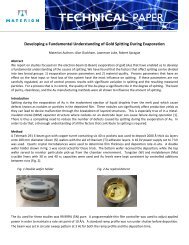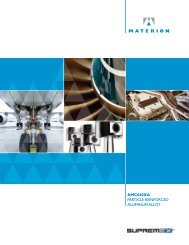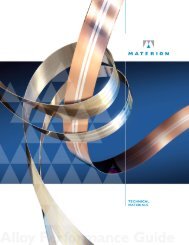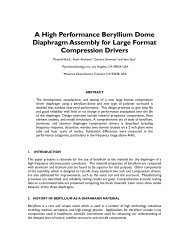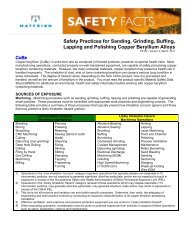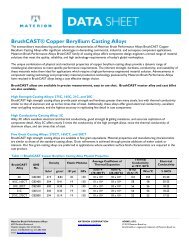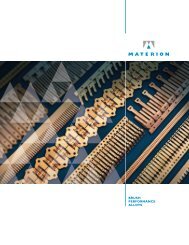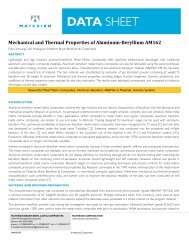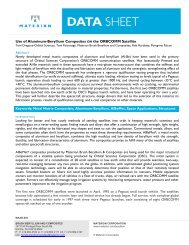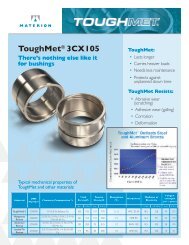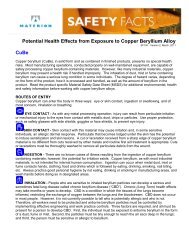Coating Materials News Vol 14 Issue 4 - Materion
Coating Materials News Vol 14 Issue 4 - Materion
Coating Materials News Vol 14 Issue 4 - Materion
Create successful ePaper yourself
Turn your PDF publications into a flip-book with our unique Google optimized e-Paper software.
2<br />
Achieving Low Mechanical Stress in Thin Film Layers<br />
Thin film layers that have high tensile or<br />
compressive stress in relation to their substrates<br />
are vulnerable to mechanical failure<br />
that may take many forms, ranging from<br />
increased scatter due to micro-cracking to<br />
catastrophic flaking and peeling. In general,<br />
fluoride films grow with tensile stress<br />
while the stress in oxide-compound films<br />
can range from compressive to tensile, depending<br />
on many parameters. CMN<br />
previous issues have treated the subject of<br />
stress in thin-film layers: CMN V1, <strong>Issue</strong><br />
3 (1991); V2, <strong>Issue</strong> 3 (1992); and V11, <strong>Issue</strong><br />
4 (2001). Low-stress mixtures of oxide<br />
compounds were discussed in CMN V2,<br />
I3 (1992) and V8, I4 (1998). New information<br />
was presented at the Tucson 2004<br />
Optical Interference <strong>Coating</strong>s Meeting that<br />
deserves review.<br />
Zirconium dioxide is a material with exceptional<br />
hardness, moderately high refractive<br />
index and high transparency from ~300 nm<br />
to ~11 ì m, thus is useful in optical and<br />
tribological coatings. Layers of pure of<br />
ZrO 2 share a common characteristic with<br />
many refractory compounds: they exhibit<br />
inhomogeneous refractive index depth profiles,<br />
resulting in difficulties in applications<br />
such as efficient AR coatings. The origin of<br />
CERAC Pre-Melted TiO 2 , from page 1<br />
TiO 2 rod,<br />
cones &<br />
pieces<br />
this stress is known to be the presence of<br />
multiple or unstable crystalline forms<br />
throughout the layer.<br />
The effects of the thermal history on residual<br />
stress in ZrO 2 layers on glass were<br />
studied by monitoring the evolution of crystallinity<br />
using XRD [1]. Stress was<br />
measured in films that were deposited by<br />
E-beam on substrates at temperatures between<br />
room and 350° C. The room<br />
temperature films were then annealed in air<br />
for 1 hour at temperatures 200° C, 300° C<br />
and 400° C. For films deposited at room<br />
temperature to 190° C, the residual stress<br />
was tensile: 64 and <strong>14</strong> MPa, respectively.<br />
At 260° C the stress became -46 MPa compressive;<br />
and at 350° C it increased to -150<br />
MPa. Films deposited at room temperature<br />
changed from tensile to increasing values<br />
of compressive as the annealing temperature<br />
was increased, reaching -240 MPa at<br />
350° C. XRD showed evolving crystallinity<br />
from amorphous for films with thermal<br />
histories below 200° C to monoclinic and<br />
tetragonal at the higher temperatures. The<br />
densities and residual compressive stresses<br />
of the high- temperature films increase in<br />
correspondence with contraction of the<br />
microstructure with crystallization.<br />
chamber time. This non-productive<br />
use of vacuum chamber time<br />
has been reduced to


